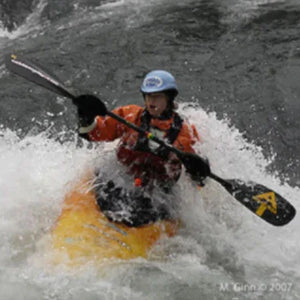The Mighty PFD: Personal Flotation Safety For Kayakers
December 01, 2022

Whether you call them lifevests, lifejackets or PFDs (personal flotation devices) — what is important is that you wear one while kayaking. We will call them PFDs for purposes of this blog post. Wearing a PFD will help keep you afloat when you end up in the water, either intentionally or not.
Even if you’re a good swimmer you should still wear a properly fitted and environment-appropriate PFD. Cold water, aerated water or situations where you might bump your head and become unconscious are all scenarios where a PFD can mean the difference between life and death.
PFD Law
In the US you are required by the United States Coast Guard (USCG) to have an appropriate PFD close at hand while kayaking. The following are the basic USCG PFD rules:
- Have at least one USCG approved Type I, II, III or V PFD per person,
- PFD must be appropriately sized for intended wearer,
- Must be in good and serviceable condition, and
- Must be readily accessible, meaning you are able to put the PFD on quickly in an emergency.
While the law does not require you to ‘wear’ your PFD while kayaking, it is highly recommended you do so. This is especially true if you are paddling in rough water, cold water, are new to kayaking or not a great swimmer. If you’ve got it with you, why not just go ahead and put it on!
The Stohlquist Edge Lifejacket (PFD) is a great general purpose jacket for all types of boating.
PFD Types
Type USCG certified Type III and V are the most common PFD types used in kayaking. They tend to be the most comfortable, best suited for sitting in a kayak and are relatively easy to swim in.
A Type III PFD is by far the most common type of kayak lifejacket. Type III come in a wide variety of styles and shapes, which are specifically designed to work well with different styles of kayaking.
The NRS Chinook Fishing Lifejacket (PFD) is a Type III PFD specifically designed with anglers in mind.
Some Type III are Inflatable PFDs
Inflatable PFDs, can be extremely comfortable and cool. But they may also require regular maintenance with CO cartridge replacement or not be suitable for some types of kayaking. Best to read the details on their product pages to see if they are suitable for you.
Type V are special use PFDs that also meet all the requirements of a Type III. In kayaking you will find many youth and swift-water rescue PFDs to be Type V. Rescue PFDs are more popular with paddlers that have taken a professional Swiftwater Rescue Class or a formal Search and Rescue Class. These boaters are familiar with towing an injured kayaker as well as assisting another kayaker to re-enter their kayak after a failed roll or other rescue scenarios. We don’t recommend someone wearing the quick release rescue belt on their rescue PFD if they haven’t been formally trained to use it.
Buoyancy
While PFDs are all about keeping you afloat, you generally don’t need to worry about buoyancy. The average person only needs 7-12 lbs of floatation to stay afloat, and USCG certified kayaking PFDs provide 15.5 to 22 lbs of floatation.
PFD Fit
The real key to buying the right PFD is getting one that fits you properly and provides enough mobility to allow you to kayak with the least restriction. Adult PFD sizing is based on chest size, not weight. Measure the circumference of your chest at its broadest point to get your chest measurement. Use this number to determine your correct size, based on each PFD manufacturers’ sizing recommendations.
Kokatat Hustle Lifejacket (PFD) allows for ample adjustability, perfect for a wide range of boaters.
Women might want to consider a women’s specific PFD, as they typically will fit a women’s body better than a unisex one. Contoured cups at the bust line, shorter torso profile and different PFD foam patterns help to make these PFDs fit more appropriately to a woman's body. Look for the lifejackets that say “Women’s or Female” in the title for the women's specific PFDs.
Type Of Kayaker
The type of kayaking you do will greatly point you in the direction of which PFD will best suit your needs. There are special use PFDs, like the NRS Chinook for kayak fishing and some PFDs, like the Stohlquist Edge, that are well suited for most types of kayaking.
If you are a recreational flatwater kayaker you might want to consider the Astral EV-Eight Lifejacket or the NRS Ion. These PFDs are lightweight, comfortable and a good value.
If you are a sea kayaker you might want to consider the Kokatat OutFIT Tour Lifejacket or the Astral BlueJacket. These PFDs offer lots of storage, comfort with a low seat back and offer lots of mobility.
If you are a whitewater kayaker you might want to consider the Stohlquist Descent or the Kokatat Maximus Centurion. These PFDs are extremely durable, are easy to swim in and allow for maximum mobility while protecting your torso during swims.
PFD Storage/Care
Once you’ve picked the right PFD for your needs and budget it is important to take care of that PFD, maximizing its useful life. Sunlight, salt water and dirt are the main factors that will degrade a PFD. If you paddle in salt water it is best to rinse your PFD with fresh water after each use. Be sure to hang your PFD up to dry thoroughly after each use, and store it in a dry area away from sunlight. A favorite pastime of many kayakers is to use their PFD as a changing mat or using it as a seat cushion, but this will greatly reduce the lifespan of your PFD. Don’t do it!
Is it time for a new PFD?
Once you’ve owned a PFD for some time you might notice that the materials start to look a bit faded. The stitching starts to come undone, the foam begins to shift around and the padding starts to retain water. Once you notice these signs it is probably time to consider a new PFD for your kayaking adventures.
There is no generally accepted rule as to how long a PFD should last because there are so many factors that affect a PFD’s longevity. However, a well taken care of, high quality PFD should last about 5 years or 300 use days.
Bonus Safety Tip
The USCG also requires all kayakers to carry an efficient sound-producing device, such as a whistle or horn that is audible for at least one-half mile. Not only is this required, but a really good idea. A great option is to attach a loud whistle, like the Fox 40 Classic Whistle, to the zipper pull on your PFD. That way it is always readily accessible.
Stay safe and happy paddling!





